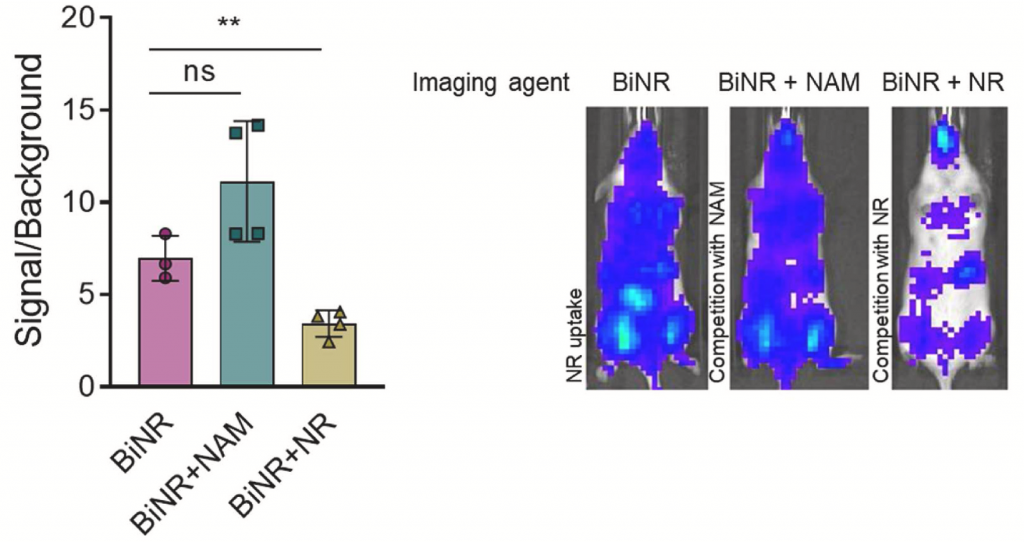Key Points:
- A novel bioluminescent probe can measure the cell and tissue uptake of an NR analog called AzNR.
- The probe, known as BiNR, seems to move into cells and tissues similarly to NR.
- BiNR shows that NR supplementation in immunocompromised mice may cause cancer metastases from highly aggressive primary tumors.
Nicotinamide riboside (NR) is a form of vitamin B3 found in milk, yeast, and other foods. In the last decade, it has been touted to have anti-aging benefits with minimal side effects. However, a recent study put forward evidence that NR may affect how cancer spreads to secondary areas in the body.
The study, borne out of a collaboration between institutions in Missouri and Switzerland, published in Biosensors and Bioelectronics, focused on a novel way of monitoring NR uptake into cells and tissues. Using this method, the researchers looked at the role of NR uptake in cancer progression in immunocompromised mice injected with highly aggressive cancer cells. They found that NR supplementation leads to brain metastases in this animal model.
“These results emphasize the importance of understanding the underlying biology and safety profiles of potent nutraceuticals such as NR before recommending their supplementation to certain patient populations,” the scientists wrote.
Modified NR Causes Metastases of Aggressive Cancer in Immunocompromised Mice
To create a bioluminescent probe that visualizes NR uptake into tissues and cells (called BiNR), scientists changed the structure of the NR molecule – possibly changing its reactivity. They dubbed this modified NR, AzNR, and it illuminates when it is taken up into cells. BiNR was shown not to be fatal in all cells, tissue, and animals used.
The researchers performed experiments to determine the relevance and specificity of BiNR as an NR stand-in. They performed a competitive assay between NR and BiNR, assessing bioluminescent levels as they increased the concentration of NR. It was found that in both cells and animals, NR and BiNR did compete, suggesting that BiNR behaves like NR. Furthermore, inhibitors to NR uptake decreased bioluminescence, indicating that BiNR behaves similarly to native NR. However, using AzNR did not increase NAD+ levels, as non-modified NR does.

While NAD+’s effects on cancer have been studied due to its role in many cellular processes, NR – its precursor – has not been well studied. Using their BiNR probe, the researchers looked at NR uptake in multiple human breast cancer cell lines. The more aggressive cancer lines (triple negative breast cancer (TNBC)) showed nearly four times higher bioluminescence than less aggressive types, indicating greater BiNR uptake.
To determine whether NR supplementation affected metastases, the investigators used an immunocompromised mouse model fed either a standard diet or an NR-enriched diet. They then injected them with TNBC human cells after two weeks on the diet. By week ten, 70% of mice from the NR group had detectable tumors, while 55.5% from the control group had tumors. Furthermore, when the cancer cells were injected into the heart, 9 out of the 11 mice in the NR group had multiple cancer growths in their brains (metastases), while 3 out of 12 mice in the control group had metastases. The scientists suggest that NR results in increased cancer prevalence and an increased rate of metastases.

NR Does Not Cause Cancer
Maric and colleagues make the case that NR supplementation may increase the risk of cancer metastases. However, they injected very aggressive cancer cells into immunocompromised mice. In non-immunocompromised mice, cancer cells are more likely to be killed off by an intact immune system, especially with less aggressive cancers. Still, it is possible that NR could promote the spread of existing cancers, suggesting that cancer patients should not take NR.
Additionally, their hypothesis that NR helps degrade the blood-brain barrier enabling brain metastases, is contradictory to other NR studies. Other studies have shown that NR helps maintain the blood-brain barrier – the selectively permeable barrier preventing foreign material from getting into the brain – and can help maintain brain health. However, this study does highlight the need for more supplement research in specific patient populations, particularly cancer patient populations and the need for personalized medicine. As always, discuss with your doctor before starting any new supplements.